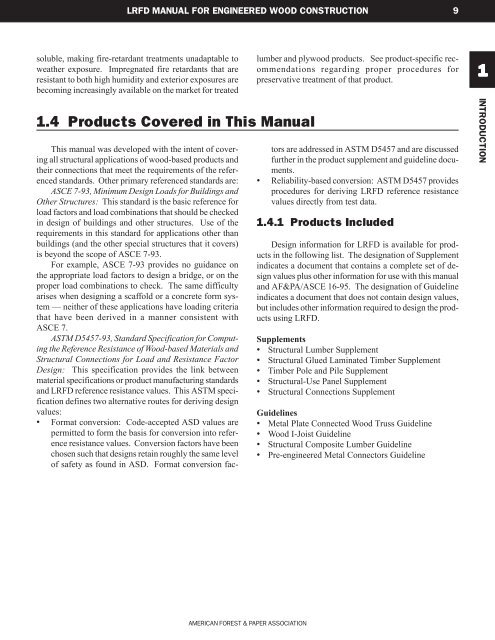1996 LRFD Manual for Engineered Wood Construction
1996 LRFD Manual for Engineered Wood Construction
1996 LRFD Manual for Engineered Wood Construction
Create successful ePaper yourself
Turn your PDF publications into a flip-book with our unique Google optimized e-Paper software.
GUIDELINE<strong>LRFD</strong> MANUALTO <strong>LRFD</strong>FORFORENGINEEREDSTRUCTURALWOODCOMPOSITECONSTRUCTIONLUMBER 9This manual was developed with the intent of coveringall structural applications of wood-based products andtheir connections that meet the requirements of the referencedstandards. Other primary referenced standards are:ASCE 7-93, Minimum Design Loads <strong>for</strong> Buildings andOther Structures: This standard is the basic reference <strong>for</strong>load factors and load combinations that should be checkedin design of buildings and other structures. Use of therequirements in this standard <strong>for</strong> applications other thanbuildings (and the other special structures that it covers)is beyond the scope of ASCE 7-93.For example, ASCE 7-93 provides no guidance onthe appropriate load factors to design a bridge, or on theproper load combinations to check. The same difficultyarises when designing a scaffold or a concrete <strong>for</strong>m system— neither of these applications have loading criteriathat have been derived in a manner consistent withASCE 7.ASTM D5457-93, Standard Specification <strong>for</strong> Computingthe Reference Resistance of <strong>Wood</strong>-based Materials andStructural Connections <strong>for</strong> Load and Resistance FactorDesign: This specification provides the link betweenmaterial specifications or product manufacturing standardsand <strong>LRFD</strong> reference resistance values. This ASTM specificationdefines two alternative routes <strong>for</strong> deriving designvalues:• Format conversion: Code-accepted ASD values arepermitted to <strong>for</strong>m the basis <strong>for</strong> conversion into referenceresistance values. Conversion factors have beenchosen such that designs retain roughly the same levelof safety as found in ASD. Format conversion facsoluble,making fire-retardant treatments unadaptable toweather exposure. Impregnated fire retardants that areresistant to both high humidity and exterior exposures arebecoming increasingly available on the market <strong>for</strong> treatedlumber and plywood products. See product-specific recommendationsregarding proper procedures <strong>for</strong>preservative treatment of that product.11.4 Products Covered in This <strong>Manual</strong>tors are addressed in ASTM D5457 and are discussedfurther in the product supplement and guideline documents.• Reliability-based conversion: ASTM D5457 providesprocedures <strong>for</strong> deriving <strong>LRFD</strong> reference resistancevalues directly from test data.1.4.1 Products IncludedDesign in<strong>for</strong>mation <strong>for</strong> <strong>LRFD</strong> is available <strong>for</strong> productsin the following list. The designation of Supplementindicates a document that contains a complete set of designvalues plus other in<strong>for</strong>mation <strong>for</strong> use with this manualand AF&PA/ASCE 16-95. The designation of Guidelineindicates a document that does not contain design values,but includes other in<strong>for</strong>mation required to design the productsusing <strong>LRFD</strong>.Supplements• Structural Lumber Supplement• Structural Glued Laminated Timber Supplement• Timber Pole and Pile Supplement• Structural-Use Panel Supplement• Structural Connections SupplementGuidelines• Metal Plate Connected <strong>Wood</strong> Truss Guideline• <strong>Wood</strong> I-Joist Guideline• Structural Composite Lumber Guideline• Pre-engineered Metal Connectors GuidelineINTRODUCTIONAMERICAN FOREST & PAPER ASSOCIATION
















